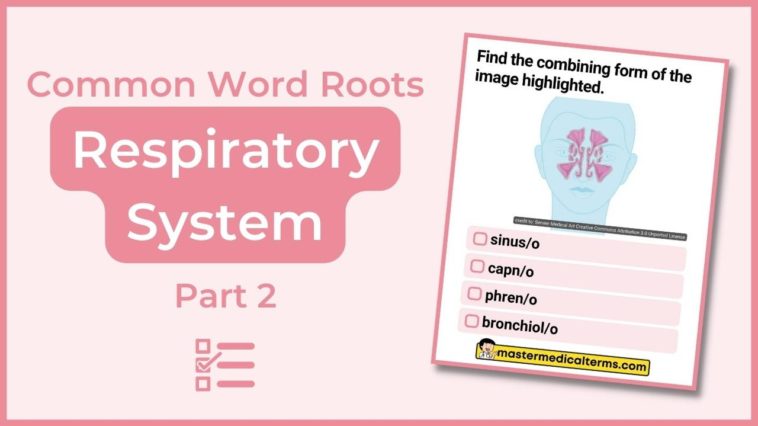Quick Review for the Quiz
Check out the flashcard version for a more detailed review.
| Word Root | Combining Form | Body Part or Condition |
|---|---|---|
| pharyng | pharyng/o | pharynx |
| phon, son | phon/o, son/o |
sound, voice
|
| phren, diaphragmat | phren/o, diaphragmat/o | diaphragm |
| phrenic | phrenic/o |
phrenic nerve
|
| pleur | pleur/o | pleura |
| pulm, pulmon, pneumon, pneum, pneumat | pulm/o, pulmon/o, pneumon/o, pneum/o, pneumat/o |
lungs or respiration
|
| radi | radi/o |
x-rays or ionizing radiation
|
| sept | sept/o | septum |
| sinus | sinus/o | sinus |
| spir, respir | spir/o, respir/o | breathing |
| thorac | thorac/o |
thorax or chest cavity
|
| trache | trache/o | trachea |
-
Question of
Find the combining form of the image pointed to.

-
pharyng/o
-
phrenic/o
-
son/o
-
laryng/o
Correct Wrong
pharyng/o is a combining form that refers to "pharynx". The pharynx is a part of the respiratory system as well as the digestive system. It is responsible for carrying air, food, and fluid from the nose and mouth to the stomach.
-
-
Question of
Find the combining form.

-
phon/o or son/o
-
capn/o
-
bronch/o or bronch/i
-
diaphragmat/o
Correct Wrong
phon/o or son/o is a combining form that refers to "sound" or "voice". In simple terms, sound is the sensation caused by vibrations that occur at frequencies between 20 and 20,000 hertz that stimulate the ear.
-
-
Question of
Find the combining form of the image highlighted.

-
phren/o or diaphragmat/o
-
pharyng/o
-
spir/o or respir/o
-
trache/o
Correct Wrong
phren/o or diaphragmat/o is a combining form that refers to "diaphragm". Under the lungs, the diaphragm is the most critical muscle of respiration. The muscle is large, dome-shaped, and it contracts rhythmically, repeatedly, and involuntarily most of the time.
-
-
Question of
Find the combining form of the image pointed to.

-
phrenic/o
-
nas/o or rhin/o
-
ox/i
-
lob/o
Correct Wrong
phrenic/o is a combining form that refers to "phrenic nerve". The phrenic nerve is a vital part of your respiratory system that facilitates breathing. Only this nerve sends signals that cause your diaphragm to expand and contract.
-
-
Question of
Find the combining form of the image pointed to.

-
pleur/o
-
laryng/o
-
phrenic/o
-
diaphragmat/o
Correct Wrong
pleur/o is a combining form that refers to "pleura". The pleura is a thin layer of tissue that covers the lungs and lines the chest cavity to protect and cushion them.
-
-
Question of
Find the combining form.

-
pulm/o or pneumon/o
-
sinus/o
-
nas/o or rhin/o
-
bronchiol/o
Correct Wrong
pulm/o, pulmon/o, pneumon/o, pneum/o or pneumat/o is a combining form that refers to "lungs" or "respiration". The process of respiration involves the exchange of oxygen from the outside environment to the cells within tissues, as well as the removal of carbon dioxide in the opposite direction.
-
-
Question of
Find the combining form.

-
radi/o
-
bronch/o or bronch/i
-
phon/o or son/o
-
trache/o
Correct Wrong
radi/o is a combining form that refers to "x-rays" or "ionizing radiation". An X-ray is electromagnetic radiation capable of passing through most objects, including the human body. The images of structures inside the body are obtained by using medical x-rays. X-ray is an example of ionizing radiation.
-
-
Question of
Find the combining form of the image pointed to.

-
sept/o
-
muc/o
-
thorac/o
-
alveol/o
Correct Wrong
sept/o is a combining form that refers to "septum". A nasal septum is a cartilage and bone in the nose that separates the nasal cavity (inside your nose) into two left and right sections.
-
-
Question of
Find the combining form of the image highlighted.

-
sinus/o
-
capn/o
-
phren/o
-
bronchiol/o
Correct Wrong
sinus/o is a combining form that refers to "sinus". In addition to the nasal cavity, there are four pairs of air-filled spaces called paranasal sinuses. A primary function of the paranasal sinuses is to protect the body, mostly by humidifying inhaled air and facilitating immune responses.
-
-
Question of
Find the combining form.

-
spir/o
-
alveol/o
-
ox/i
-
trache/o
Correct Wrong
spir/o or respir/o is a combining form that refers to "breathing". A spirometry test is one of the most common types of tests that can be performed to assess lung function or breathing.
-
-
Question of
Find the combining form.

-
thorac/o
-
sept/o
-
radi/o
-
phrenic/o
Correct Wrong
thorac/o is a combining form that refers to "thorax (chest cavity)" In the body, the thorax is located between the neck and the abdomen. The thorax contains several vital organs, such as major blood vessels, the heart, and the lungs.
-
-
Question of
Find the combining form of the image pointed to.

-
trache/o
-
capn/o
-
rhin/o
-
sept/o
Correct Wrong
trache/o is a combining form that refers to "trachea" Trachea (also called windpipe) connects the larynx (voice box) to the bronchi (large airways that lead to the lungs).
-




